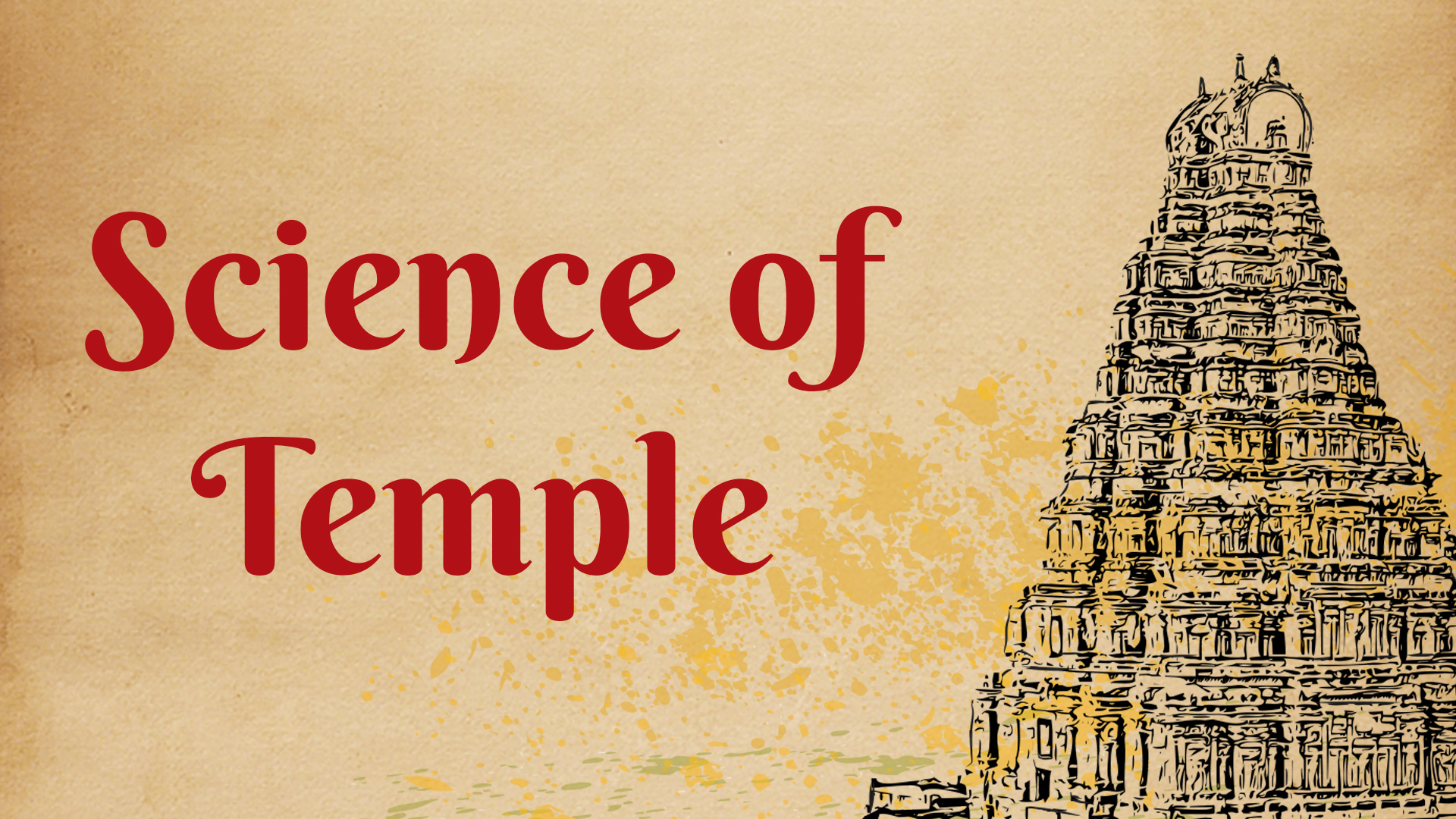In the esteemed land of India, a nation renowned for its opulent culture and timeless traditions, one practice stands out above all others – the devout pilgrimage to temples. Each day, or on specific sacred occasions, countless individuals partake in this custom, seeking solace within the hallowed walls of these divine sanctuaries. This age-old ritual serves to quiet our restless minds and nurture a profound sense of inner tranquility. For within the sacred temple grounds, we believe we are granted a rare opportunity; a chance to reunite our souls with the divine through heartfelt prayers and solemn offerings. However, a perplexing paradox arises – if it is widely accepted that God permeates every corner of creation, omnipresent and boundless, then why do we partake in this time-honored tradition? To unveil the answer to this profound question, we must embark on a quest to comprehend the profound science underlying temple worship as ordained by our venerable Sanatan Vedic Tradition.
Within the annals of our scripture, the distinction between two forms of divine worship is revealed – the Nirakar (formless) and the Sakar (form). The Nirakar, veiled from mortal eyes, exists beyond the realm of perceivable existence. It is a universal form that transcends the confines of time and space, eternal and unchanged across the boundaries of our triloka, the three realms of existence. On the other hand, the Sakar takes on a tangible shape, one beholden to our mortal senses; it can be seen and comprehended by our human faculties.
According to the ancient texts that serve as our guiding light, the worship of the Nirakar is distinct and separate from its physical counterpart. In the illustrious ‘Maitreya Upanishad’, the revered Lord Shiva himself imparts wisdom to the sage Maitreya, illuminating the nuances of this mystical worship.
देहो देवालयः प्रोक्तः स जीवः केवलःशिवः।
त्यजेदज्ञाननिर्माल्यं सोऽहं-भावेन पूजयेत्।।
– मैत्रेय्युपनिषद्
“With such emotions and unity that our body is a temple and the soul that lives within our body is a God, we should worship God.”
Having unveiled the enigmatic nature of Nirakar worship, let us now delve into the realm of the Sakar form – that which possesses a tangible shape, a form perceptible to our mortal eyes. It is within the confines of this physical manifestation that we encounter the embodiment of divinity, aptly represented by the revered idols of gods. These sacred idols, carefully crafted with meticulous craftsmanship, serve as tangible vessels through which devotees can establish a direct connection with the divine.
And what better abode for this Sakar form of God, than the sanctuary known as a temple? Translated from the Sanskrit term “Mandir,” the very word itself denotes a “Home” – a sacred dwelling for the divine to grace. A profound verse, etched within the renowned Samarangana Sutradhara, lends further clarity to this concept, shedding light upon the essence of the temple as the celestial abode of Gods.
आवासः सदनम् सद्म निकेतो मन्दिरम् मतम्।
– समराङ्गन सूत्रधार
“House, Bhavan, Residence, Temple, etc. are all synonyms of Home.”
Also, in the well-known scripture named Mayamatam, it is stated that:
अमर्त्याश्चैव मर्त्याश्च यत्र यत्र वसन्ति हि
तद् वास्तु इति मन्त्रज्ञैः।
– मयमतम्
“The house where deity resides is called temple and the house where man resides is called Vastu.”
Now that we have unraveled the significance of both forms of worship and comprehended the essence of a temple, it is imperative to delve deeper into the understanding of what truly constitutes the divine – God. To unravel this profound concept, we turn our attention to the eminent Nirukt Granth, a revered tome that diligently clarifies the terminology associated with Vedic terms within our time-honored tradition. Indeed, a sound knowledge of the language and terminology pertaining to any discipline is paramount in comprehending its intricacies.
Within the sacred pages of the Nirukt Granth, a poignant verse awaits, offering a glimpse into the very essence of the deities who hold sway over our spiritual pursuits. This verse encapsulates the profound meaning and significance attributed to the divine beings who inspire our hearts and guide our souls on this spiritual journey.
देवो दानात्वा दीपनात्वा द्योतनात्वा
– निरुक्त ग्रन्थ
“The one who donates us with the fulfillment of our wishes, the one who guides us by clearing our confusion, and the one who shows us the path of truth is referred to as deity.”
Hence, the temple can be aptly regarded as a sanctuary where our deepest desires find fulfillment, where we gain unwavering guidance devoid of perplexity, and where the truthful teachings of the divine reside. It is an abode that holds immense sacredness, serving as a compass directing us toward the right path.
Further exploration into the scientific aspects of temples has brought to light intriguing findings. Esteemed experts have posited that temples function as conduits of cosmic energy, transmitting it to those who enter their hallowed halls. This cosmic energy, channeled through the intricate framework of the temple, serves to rectify the flaws in our destiny and bestows upon us vital guidance. Therefore, temples serve as invaluable instruments, fostering our holistic growth rather than mere places of congregation, psychological solace, or community development.
Dynamic in nature, a temple effectively works upon our chakras, the energy centers within our bodies. Moreover, it endeavors to alleviate or mitigate the burden of negative karma, while gently guiding us towards the optimal path by dispelling the cloud of confusion that obscures our thoughts. Thus, it becomes evident that the temple reverberates with profound power.
Our wise ancestors and the learned figures of antiquity held an inherent awareness of the temple’s significance. Even now, we continue to acknowledge the potent realm that places of worship represent. Regrettably, the ancient knowledge and architectural expertise pertaining to temple construction have gradually dwindled. Consequently, many contemporary temples deviate from the foundational science that underpins their design. Although temples abound in our surroundings, not all adhere to the principles of ancient temple architecture.
In addition to the design of a temple, the selection of its location holds equal importance. Not every temple erected upon any given site or parcel of land possesses the potential to become a resounding force. Both Vastu Shastra and Shilpa Shastra, ancient fields of study, emphasize the significance of site selection and the meticulous application of architectural principles to create powerful temple structures. In Vishwakarma Prakash, a verse has been given for the same.
प्रतिष्ठाप्या शुभे स्थाने अन्यथा ते भयावहाः।
– विश्वकर्मा प्रकाश
“The temple of the deities should always be built at the best place and on the most favorable land. And if the temple is not built on the best land, then it will give negative effects and also a feeling of fear will arise in the mind of the people who will visit such temple for worshipping.”
The passage above elucidates that constructing a temple on unsuitable land will result in a sense of unease rather than offering solace and direction. As we understand, a temple signifies a holy abode where one attains joy, tranquility, and personal evolution. Consequently, any edifice resembling a temple cannot truly be labeled as such. The Upanishads, ancient texts of profound wisdom, have provided a conceptual framework for temple construction based on their principles. Within these sacred scriptures, a definitive proclamation can be found, emphasizing that:
यत् ब्रह्माण्डे तत् पिण्डे।
– उपनिषद सूत्र
“What is present in the universe is present on the earth.”

Upon closer examination of our ancient temples, it becomes apparent that their design is intricately intertwined with the imagery of a slumbering deity. Much like the existence of chakras within our ethereal bodies, deities themselves possess these vital energy centers. Consequently, temples are constructed in alignment with the chakras of a respective deity, as if envisaging their celestial slumber in that auspicious location. It is this profound correlation that imbues temples with unparalleled potency. Moreover, temples serve as powerful instruments, activating the chakras within our own subtle bodies. Thus, it is imperative to recognize that a temple constructed without proper cognizance of its positioning on the land cannot be considered truly powerful.
Indeed, the Earth is permeated by a cosmic energy that transcends all boundaries. However, certain locations possess an abundance of this cosmic energy, which our sagacious ancestors astutely discerned. They deftly identified these sites and then erected a structure—a conduit, if you will—that would allow us to connect with the potent energy of the cosmos. This instrument, referred to as a temple, serves as an intermediary, linking the cosmic energy with the chakras of our subtle bodies. Hence, when we step into a temple, our chakras are set ablaze, charged by the available cosmic energy. This explains the serene tranquility we experience within a temple constructed in accordance with the principles of Vastu Shastra, as well as the revitalized energy we feel upon departing from its sacred confines.
To put it succinctly, there are numerous advantages that arise from visiting a temple. Firstly, the pleasure of socializing and engaging with individuals within the temple community brings immense joy. Additionally, the activation of the chakras in our ethereal beings aids in the eradication or alleviation of ailments, resulting in improved physical well-being. Therefore, a visit to a temple not only brings mental delight but also contributes to better overall health.
Moreover, the activation of our subtle body’s chakras fosters intellectual growth and consciousness development. Perhaps most significantly, visiting a place where deities reside has the power to rectify any flaws present in our destiny.
Consequently, it is advisable to approach temple visits with an open receptivity and unwavering faith in the abundant energy present there. It is crucial to keep yourself and your mind receptive to receive cosmic energy. I firmly believe that if you visit a temple constructed in accordance with Vastu principles, you will undoubtedly reap the multitude of benefits bestowed by the cosmic energy emanating from this sacred structure. Not only will it stimulate the chakras within your subtle body, but it will also have a positive impact on your physical health. Furthermore, the interactions with the temple community will provide you with an invaluable sense of inner peace.
May you be blessed with the desired happiness and serenity in life, as you delve deeper into the profound science of the temple.
Shubham Bhavatu.








